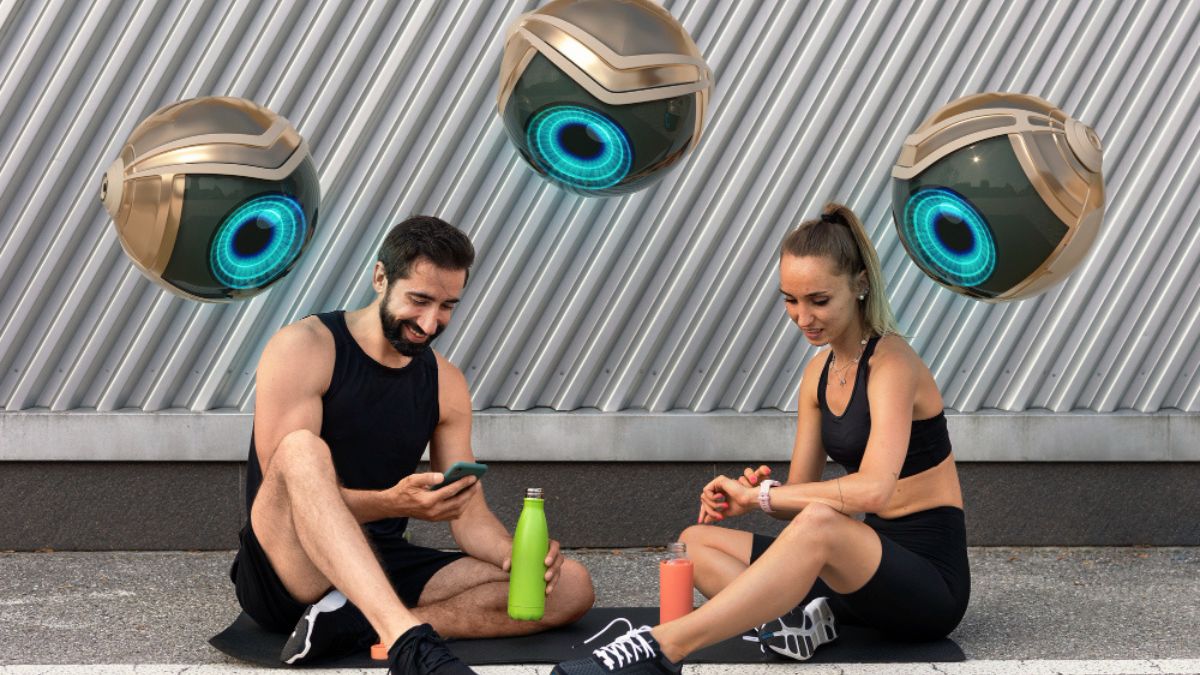It’s 7:02 AM. Your alarm screams into the peaceful silence. Your hand slams down on the snooze button with the practiced precision of a nuclear missile technician. The reason? In 58 minutes, you’re supposed to be at the gym, contorting yourself into a sweaty pretzel for a “HIIT and Abs” class you booked in a fit of Sunday-night optimism.
The thought alone is exhausting.
You love the idea of being a fitness person. You crave the energy, the strength, the clarity. But the process—the stark choice between a grueling, time-consuming workout and a shame-filled blob of inactivity—feels like a constant battle you’re losing.
What if there’s another way? What if the secret to a healthier, more vibrant life isn’t found in a 60-minute block of scheduled suffering, but in a thousand tiny, integrated moments of movement?
Welcome to Duaction.
It’s not a typo. It’s a philosophy. It’s the marriage of Dual + Action. It’s the art of layering movement and mindfulness seamlessly into the tasks you’re already doing. It’s about making your entire life your gym, and in doing so, rediscovering the joy of a body in motion.
The Problem with All-or-Nothing Fitness
We’ve been sold a lie. The fitness industry, with its gleaming machines and chiseled influencers, has convinced us that fitness is a destination. It’s a place you go for a specific time, wearing specific clothes, to perform specific, often unpleasant, tasks.
This “Binary Fitness” model creates a cycle so many of us know intimately:
-
The Guilt Spark: You see a photo, a doctor’s report, or a tight pair of jeans. Motivation ignites.
-
The Grand Gesture: You sign up for the year-long gym membership. You buy the kale. You schedule 5 AM workouts.
-
The Inevitable Crash: Life happens. A late work night. A sick child. A simple lack of willpower. You miss one workout.
-
The Domino Effect: The “all-or-nothing” switch in your brain flips to “nothing.” If you can’t do the perfect, hour-long workout, you do nothing at all. The membership gathers dust. The kale wilts.
-
The Shame Spiral: The guilt returns, even stronger, until it builds into another Guilt Spark… and the cycle repeats.
This cycle isn’t a reflection of your willpower; it’s a reflection of a flawed model. It disconnects fitness from life, turning it into a chore, an extra thing on a to-do list that’s already too long.
Duaction seeks to end this war. It proposes a truce. What if, instead of trying to find time for fitness, you simply made your time more fit?
What is Duaction? The Core Principles
Duaction is built on a simple, liberating idea: Pair a daily, mundane task with a simple, intentional movement or mindfulness practice.
It’s not about adding more to your day; it’s about enhancing what’s already there. It’s fitness by integration, not addition.
Let’s break down the core principles:
1. It’s Dual-Layered: Every Duaction has two components:
-
The Anchor Task: The necessary, everyday thing you were already going to do (e.g., brushing your teeth, waiting for the kettle to boil, sitting at your desk).
-
The Movement/Mindfulness Layer: The simple, intentional practice you layer on top (e.g., calf raises, deep breathing, a posture check).
2. It’s Consistency Over Intensity: The goal of Duaction isn’t to get your heart rate to 180 BPM. The goal is to create a rhythm of near-constant, low-grade movement and awareness throughout your day. This consistent drip-feed of activity is, for long-term health, often more sustainable and impactful than sporadic, high-intensity bursts.
3. It Reconnects Mind and Body: Duaction is as much about mindfulness as it is about movement. By consciously checking in with your body dozens of times a day, you break the cycle of “head-down” living, where we exist from the neck up, ignoring the vessel that carries us.
4. It’s Deeply Personal and Adaptive: There is no “One-Size-Fits-All” Duaction plan. Your Duactions will be based on your life, your responsibilities, your physical limitations, and your goals. It’s a framework, not a rigid prescription.
The Science of the Snack: Why Small Bites of Movement Matter
You might be thinking, “Five calf raises while I brush my teeth? How is that going to make a difference?”
The science is clear: these “movement snacks” are profoundly powerful.
-
Combating Sedentary Death: Studies have shown that prolonged sitting is an independent risk factor for a host of diseases, even for people who exercise regularly. The phrase “sitting is the new smoking” exists for a reason. Breaking up sedentary time with frequent, short bouts of light activity—like standing up and stretching every 30 minutes—dramatically improves blood sugar control, blood pressure, and metabolic health.
-
Greasing the Groove: In strength training, there’s a concept called “greasing the groove.” Instead of one exhausting workout, you perform sub-maximal sets of an exercise frequently throughout the day. This trains your nervous system to become more efficient at the movement, leading to strength gains without the systemic fatigue. Duaction is “greasing the groove” for life.
-
The Cumulative Effect: One set of calf raises is nothing. But one set, twice a day, every day for a year is over 700 sets. Consistently holding a plank for the two minutes your coffee brews adds up to over 12 hours of core strengthening per year. These tiny actions are like pennies in a savings account—individually insignificant, but collectively transformative.
Your Duaction Day: A Practical Guide from Dawn to Dusk
Let’s make this tangible. Here’s what a day infused with Duaction could look like. This isn’t a checklist to complete, but a menu of ideas to inspire your own.
The Morning Awakening
-
Anchor Task: Waking up, still in bed.
-
Duaction: The 1-Minute Body Scan. Before you check your phone, before your feet hit the floor. Close your eyes. Take three deep breaths. Mentally scan your body from your toes to your scalp. Notice any tension, any aches, any warmth. Don’t judge it, just observe it. This sets a tone of awareness for the day.
-
-
Anchor Task: Brushing your teeth (2-3 minutes).
-
Duaction: The Balance Challenge. Stand on one leg for the first minute of brushing, then switch to the other. This improves proprioception (your body’s sense of position in space), strengthens your ankles and stabilizer muscles, and is a fantastic way to ward off balance issues as you age.
-
-
Anchor Task: Waiting for your coffee to brew or your toast to pop.
-
Duaction: The Sun Salutation Simplified. Instead of staring blankly at the machine, step back into a gentle mini-yoga flow. Reach your arms to the sky, fold forward, step back into a high plank (hold for a breath), and then step or walk your hands back to your feet and roll up. Two rounds is all it takes.
-
The Workday Integration (The Duaction Goldmine)
This is where Duaction fights the sedentary beast head-on.
-
Anchor Task: Sitting down at your desk.
-
Duaction: The “Sit-and-Set” Posture Reset. Every time you sit down, take 10 seconds to reset. Pull your shoulders back and down, imagine a string pulling the crown of your head towards the ceiling, and ensure your feet are flat on the floor. This brief moment of awareness prevents the slow-motion slump.
-
-
Anchor Task: Your phone rings.
-
Duaction: The Stand-and-Deliver. Make it a non-negotiable rule: you take every phone call standing up. Better yet, pace gently. This can add 10-20 minutes of light standing/walking to a phone-heavy day.
-
-
Anchor Task: Waiting for a file to download or a video to buffer.
-
Duaction: The Desktop Stretch. Interlace your fingers and push your palms toward the ceiling. Or, sit tall, grab the side of your chair, and gently twist your torso to one side. Hold for three deep breaths. These micro-breaks prevent repetitive strain injury and refresh your mind.
-
-
The Crown Jewel of Workday Duaction: The Pomodoro Paragon.
-
Anchor Task: The break between 25-minute work sprints (the Pomodoro Technique).
-
Duaction: For your five-minute break, you do not check social media. You move. Set a timer for 5 minutes and pick one:
-
Power Zone: 10 bodyweight squats, 5 push-ups (on knees or desk), a 30-second plank. Repeat.
-
Mobility Mission: Spend the entire 5 minutes rolling your neck, your shoulders, and your ankles. Use a foam roller on your back and legs if you have one.
-
Zen Den: Step outside. Breathe the fresh air for 10 deep, intentional breaths. Walk to the end of the hall and back, focusing only on the sensation of your feet on the floor.
-
-
The Evening Wind-Down
-
Anchor Task: Cooking dinner.
-
Duaction: The Kitchen Counter Workout. While simmering, perform standing counter push-ups. While waiting for water to boil, hold onto the counter and do slow, controlled leg kicks to the side and back. While stirring, practice your single-leg balance.
-
-
Anchor Task: Watching TV in the evening.
-
Duaction: The Commercial Break Calisthenics. Or, if you’re streaming, use the natural chapter breaks. During these pauses, get off the couch.
-
Option A (Strength): A set of lunges, glute bridges, or crunches.
-
Option B (Mobility): Sit on the floor instead of the couch. This automatically improves hip mobility. While there, do some gentle seated twists or hamstring stretches.
-
Option C (Connection): Pause the show, turn to your partner, kid, or roommate, and have a 2-minute, device-free conversation.
-
-
-
Anchor Task: Washing your face/getting ready for bed.
-
Duaction: The Gratitude Balance. As you perform your nightly routine, think of one small, physical thing your body did for you that day. “Thank you, legs, for carrying me up the stairs.” “Thank you, hands, for typing that report.” This final Duaction connects movement with gratitude, ending the day on a note of appreciation rather than criticism.
-
Tailoring Your Duaction Practice: For Every Body and Life
The beauty of this framework is its infinite adaptability.
-
For the Office Worker: Your focus is on combating sitting. Prioritize Duactions that involve standing, walking, and postural resets.
-
For the Parent with Young Children: Your life is a Duaction! But be intentional. Anchor to your child’s activities. Do squats while you push them on the swing. Perform calf raises while you watch them at the playground. Practice deep breathing during naptime instead of frantically scrolling.
-
For Those with Chronic Pain or Mobility Issues: Duaction is perfect for you. It’s about working with your body. Your Duactions might be smaller: ankle circles while seated, diaphragmatic breathing during a painful moment, gently squeezing and releasing shoulder blades. The principle of consistent, mindful movement still applies powerfully.
-
For the Already-Active Athlete: Duaction isn’t meant to replace your training; it’s meant to support it. Use it for active recovery, mobility work, and reinforcing movement patterns. Practice your squat form while picking things up. Work on thoracic rotation while sitting.
The Deeper Payoff: Beyond the Physical
While the physical benefits of increased movement are undeniable, the psychological shift is where Duaction truly shines.
1. It Eradicates Guilt: When movement is your life, you can never “miss a workout.” You are successful every single day. This breaks the shame spiral and builds a positive, empowering relationship with your body.
2. It Cultivates Mindfulness: By constantly checking in with your body, you are pulled out of the anxious whirlwind of your thoughts and into the present moment. The feeling of your feet on the ground, the stretch in your spine, the fullness of your breath—these are all anchors to the here and now.
3. It Reclaims Your Time: Duaction reframes “wasted” time. Waiting in line is no longer boring; it’s an opportunity for a posture check or some subtle isometric exercises. A boring conference call is a chance to stretch. You begin to see pockets of potential everywhere.
4. It Fosters Self-Efficacy: Every completed Duaction is a tiny win. A small proof to yourself that you are in charge, that you can make positive choices. This snowballs into greater confidence in all areas of your life.
Getting Started: Your First Week of Duaction
This can feel overwhelming, so don’t try to do it all at once.
-
Pick One Anchor: Choose one recurring task in your day that you never miss. Brushing your teeth is a perfect candidate.
-
Assign One Duaction: Pair it with one simple movement. For brushing your teeth, make it the single-leg balance.
-
Practice for One Week: Don’t add anything else. Just focus on making that one Duaction an unthinking habit. Set a sticky note on your mirror if you have to.
-
Reflect and Add: After a week, notice how it feels. Do you automatically stand on one leg now? Does it feel weird not to? Then, and only then, pick a second Anchor and Duaction to layer in. Maybe it’s the “stand for phone calls” rule.
A Final Thought: Moving from a Chore to a Chorus
Fitness shouldn’t be a punishing monologue you have with yourself once a day. It should be a continuous, gentle chorus of movement, woven into the melody of your life.
Duaction is an invitation to stop fighting your day and start flowing with it. It’s an invitation to listen to the subtle whispers of your body—its need to stretch, to strengthen, to breathe, to balance—and to answer those whispers not with a delayed, dramatic shout, but with a thousand quiet, immediate “yeses.”
So the next time you’re waiting for the kettle to boil, don’t just wait. Reach for the sky. Feel the stretch. Take a deep breath. You’re not just making coffee.
You’re practicing the art of Duaction. You are building a healthier life, one small, integrated movement at a time.






